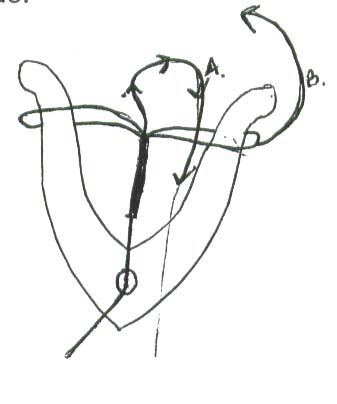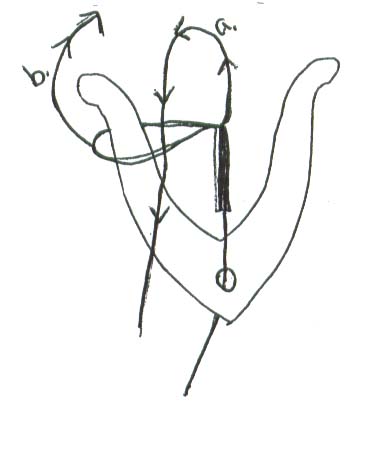

A lucet is a simple 2 pronged device used during the Middle Ages (and earlier and later) for making cords. It is most often associated with the Viking Era but were used through out Europe. It makes a strong either square or flat cord.
Lucets were made of horn, bone or wood. The cords, also called chains, were used as drawstrings in clothing and bags or purses. They were also used ornamentally as trim on clothing and other items and to hang items from belts. Larger versions of these cords were probably also used by sailors.

Making Your Own Lucet
A lucet can be made from any 2 pronged item. My first lucet was a plastic 2 pronged fork. My second lucet was a large wooden fork with the center prongs removed. The lyre shape can be cut out of 1/4 inch wood such as pine or oak and then the edges sanded.

Basic Square Cord
Crochet thread or thin yarn is good for beginners to start with.
1. Drop a 6 inch tail of the thread through the hole going from front to back. If your lucet doesn't have a hole, it is not a problem, just pull the tail around to the back of the lucet.
2. Holding the lucet in your left hand with the thumb holding the tail in place above the hole, wind the thread as shown: front to back on the right arm, then front to back on the left arm and then front to back on the right arm again, making a "figure 8." The thread should now be on teh back side where you can hold it between two fingers to keep it snug around the arms.

3. Grasping the lower thread on the right side from the back (behind the right arm) with your right hand pull it over the top loop and over the right arm. Gently, pull the thread (not the tail) back and forth to tighten and center the half knot halfway between them.


4. Wrap the thread around the left arm from back to front and again hold the thread in back with the left hand.
5. On the left side, grasp the lower loop in front of the arm and pull to loosen it, then lift it over the upper loop and the arm. Pull the thread gently back and forth to tighten the knot and center it between the arms.
6. To begin the next row, pull the thread to the front and wrap around the right arm from front to back wrapping above the existing loop. Then repeat steps 3, 4 and 5.
Casting off: At the end of a completed knot (between steps 5 and 6), cut the thread leaving about 6 inches of thread. Drop the end of the thread down the loop on the right side, then lift the right loop off and pull the thread until the loop is completely tightened. Repeat on the left side.


Finishing off the cord
You may finish the ends of the cord by threading the tail with a needle and weaving the tails back into the end of the cord.
Remember (except for casting on), the right arm wraps front to back (loosens by pulling from the back) and the left arm wraps from the center back around the front (loosens by pulling from the front)
It might be wise to mark the front of the lucet somehow in the beginning and I reccommend you always end with a completed knot (between steps 5 and 6) before laying the lucet down and taking a break. This way you always know where to begin and which side is the front when you pick it up to work again.
After you've made the cord several rows long, you can let go of the tail and hold the bottom of the cord for better stability and a more evenly braided cord.
A gentle pull from the back on the right or the front on the left should loosen the threads adequately so you can pull them over the top. You will not be able to loosen by pulling on the wrong thread.
Beware of wrapping the thread too tightly or pulling the knot too tight or it will make loosening the thread to pull it over the top much, much more difficult. Just make things snug. Your level of tension will become natural after you've practiced awuile and gotten into the rhythm. If you find it difficult to pull the loop over the top or you break the thread, your tension is probably too tight.

Two Color Cord with one color accenting the other.
The first color thread is the base that the cord is primarily made from and the second color thread is merely passed back and forth through the cord. The finished cord will be the first color with dashes of the second color visible on 2 sides of the cord. This is good for making a colored cord with gold or silver accents.
1. Thread the lucet with the first color.
2. Work the first row on both the right and left sides of the lucet.
3. Lay the second color thread across the middle of the cord from back to front, letting the tail hang down through the hole.
4. Work the right and left sides in the first color over top of the second color thread.
5. Move the second color thread over the top across the middle of the cord to the back and lay aside again.
6. Work the right and left sides in the first color over the top of the second color thread.
7. Continue working the first color and alternating the second color thread from front to back.
***If you wish you can also alternate the first and second color thread positions. After completing a row, pull the first color thread to the back and pick up the second color. Wrap the second color around the right and left sides (you will have to pull on the first thread to tighten the knots). After you have completed the first row with the second thread, you then pass the first thread, (now hanging down the back) back and forth as you work the rows with the second thread.

Two Color Cord
1. Thread the lucet with the first color as usual.
2. Thread the lucet with the second color, positioning the second thread above the first.
3. Work the right side of the lucet by lifting the first thread over the second thread and tightening, then lift the second thread over and tighten.
4. Work the left side of the lucet by lifting the first thread over the second thread and tightening, then lift the second thread over and tighten.
5. Wrap the first color thread around the right side and work it lifting the second color over the top and tighten, then wrap the first color around the left side and work it, lifting the second color over the top and tighten.
6. Wrap the second color thread around the right side and work it lifting the first color over the top and tighten, then wrap the second color around the left side and work it, lifting the second color over the top and tighten.
Continue switching from the right to left and alternating wrapping the two colors until desired length is reached.
***This method may also be used to work a 3 color cord.

Beaded Cords
1. Thread all of the beads that you will need onto your working thread and push them out of the way.
2. Begin the cord following the basic instructions.
3. Drop a bead at the start of each row where a bead is desired. Hold the bead next to the center knot and wrap the thread around the right and left sides and continue following the basic instructions normally. Depending on the size of bead, you may want to drop a bead every row or every so many rows.
*** To place beads on opposite sides of the cord drop a bead on the right side, wrap the right side, then drop a bead on the left side and wrap the left side. The bead will float on the thread behind the left side. You will need to move the left bead with the knot as you tighten it. Remember that the bead on the left side won't be locked in place next to the center cord until the next row. So plan ahead.

For more information, left-handed instructions and various techniques for single and multiple thread cords as well as picots and beaded cords, see Lucet Braiding by E. Fuller. It is available from the publisher at, Lacis
Bibliography
Fuller, E. Lucet BraidingBerkley, CA: Lacis Publications. 1998 ISBN: 1-891656-06-6
Groves, Sylvia. A History of Needlework tools and accessories.
Staples, Kathleen. "Chain Lace, Watch Guards and Sailors' Sinnets: The Craft of the Lucet." Sampler and Antique Needlework Quarterly Spring 2002. Birmingham, AL: Hoffman Media Inc.
Return to the Medieval Arts Page.
Unless otherwise noted, all text and drawings are copyright 2004 P. Girard
Email the page owner Lady Almaith